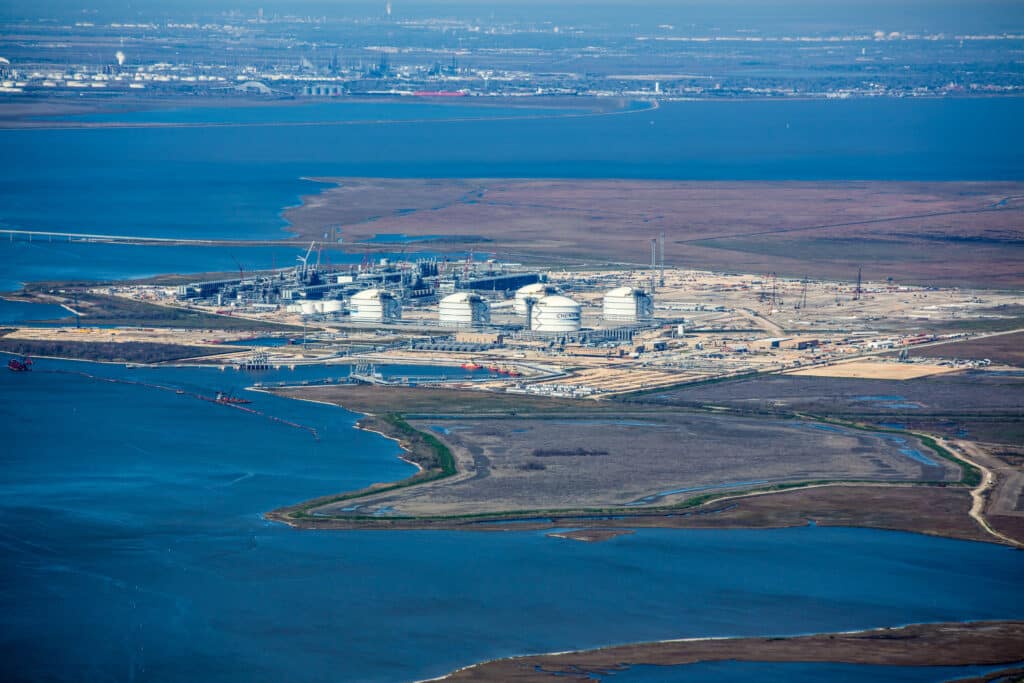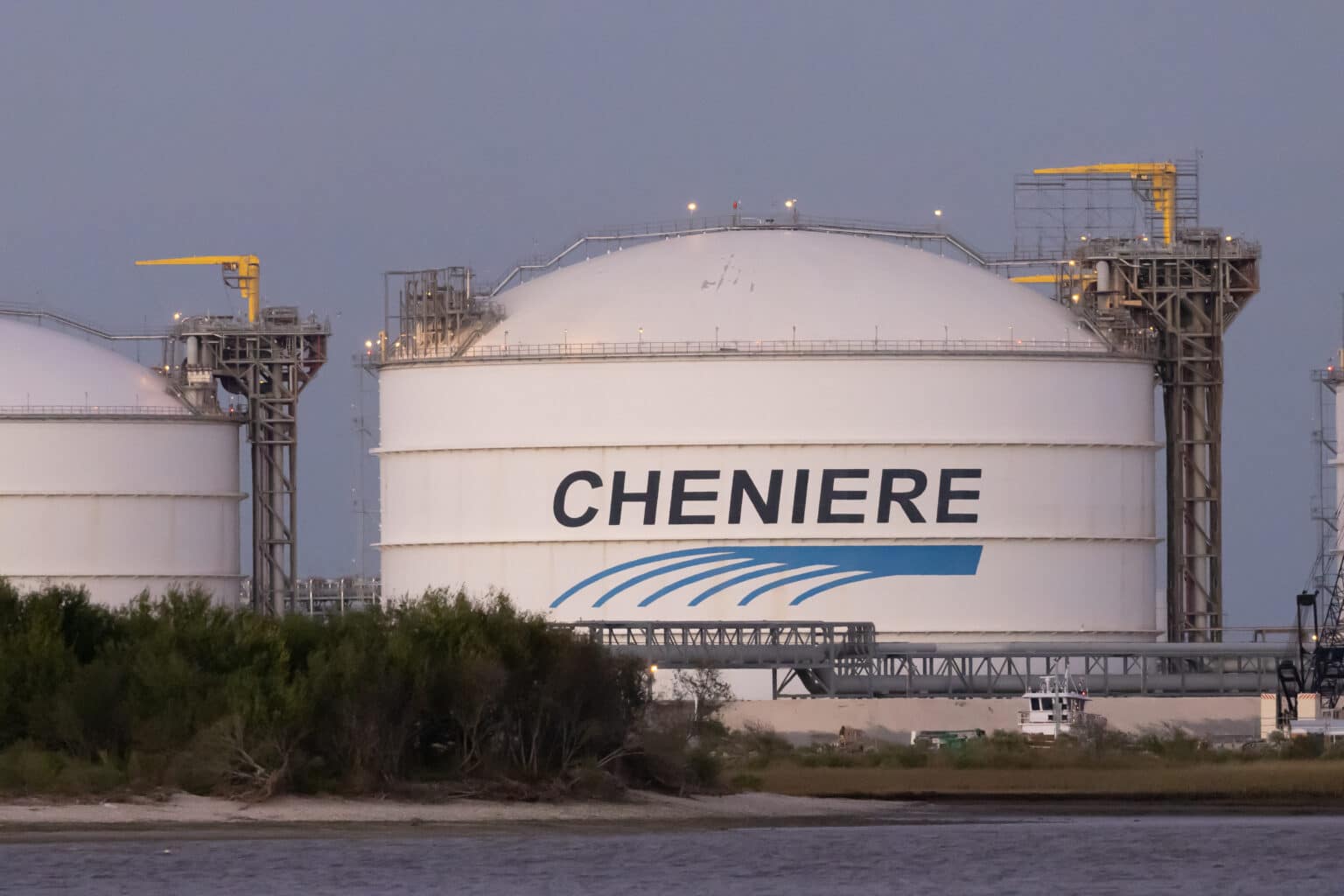A major exporter of U.S. liquefied natural gas is “seeking to greenwash” its operations in order to portray gas exports as a climate solution and clear the way for further expansion, according to a new report.
Global demand for gas has soared in the wake of Russia’s war in Ukraine, sparking a scramble by U.S. gas exporters to increase export volumes, with the backing of the Biden administration. But building out LNG infrastructure to address an energy crisis is at odds with governments simultaneously trying to slash emissions to address the climate emergency.
In recent months, Cheniere Energy, the largest LNG exporter in the United States, has begun providing emissions data, which it calls “carbon emissions tags,” or CE tags, for its gas.
The tags quantify the greenhouse gas emissions of a given LNG cargo, with the aim of easing buyers’ concerns. The CE tags include emissions from where the gas is drilled upstream, all the way down to the point of export on the coast. The logic is to offer transparency to buyers overseas by disclosing the emissions of each shipment, which would help to clean up the supply chain over time.
But a new report from Oil Change International and Greenpeace USA says the program is riddled with flaws and is broadly aimed at portraying LNG as a clean fuel, rather than actually cleaning up the supply chain, at a time when gas developers are hoping to take advantage of the war in Ukraine to expand operations.
“The industry realizes they have a problem with methane emissions,” Tim Donaghy, a senior research specialist for Greenpeace USA and a coauthor of the report, told DeSmog. He pointed to the 2020 decision by French energy company Engie to back out of a U.S. LNG deal over concerns about runaway methane emissions in American fracking fields. Donaghy said that event hammered home the message to the U.S. gas industry “that they do have to clean up their act, or at least be seen as making progress.”
Cheniere has responded to growing climate concerns by pointing to a study that it funded that shows that emissions from its Sabine Pass facility in Louisiana could displace electricity generated by coal in China, cutting emissions intensity by 47 to 57 percent. Cheniere then introduced CE tags to quantify the emissions of its LNG cargoes.
Data Problems Obscure Methane Emissions
But Cheniere’s CE tags downplay the industry’s environmental impact, Donaghy said. They rely on EPA calculations that have been shown to underestimate methane releases by shale drillers. The general rule of thumb is that if gas drillers are leaking more than 3.2 to 3.4 percent of the gas they produce, then gas is worse for the climate than coal. The EPA assumes a national methane leakage rate of about 1.4 percent. But it uses models, rather than actual measurements.
Studies have shown that the EPA has consistently undercounted methane pollution from oil and gas operations. The Permian basin in West Texas and New Mexico is particularly dirty — a recent study pegged methane leaks at 9.4 percent, six times worse than EPA estimates, and offered evidence that Permian gas is vastly worse for the climate than coal.
“In the scientific literature, people have come around to the perspective that the EPA is sort of systematically underestimating methane emissions from oil and gas infrastructure,” Donaghy said. And because Cheniere’s data is premised on the EPA approach, it too is undercounting methane, the report alleges.
In addition to undercounting methane, the CE tags don’t actually offer the transparency that Cheniere claims.
Cheniere says that its CE tag program tracks emissions for each LNG cargo. But there are problems here as well. The data is not specific to each cargo, but instead uses an average of emissions from all of Cheniere’s upstream suppliers over the course of a year. As a result, a CE tag accompanying an LNG shipment cannot link emissions back to specific gas wells in Texas or Louisiana at a particular time, for example.
Similarly, Cheniere says its CE tags offer clarity on where it is getting its gas — that it can be traced back to specific drillers. But 42 percent of the gas it ships comes from marketers who pool together gas from various sources. In other words, the origin of nearly half of Cheniere’s gas is virtually impossible to trace.
Meanwhile, the data Cheniere uses is based on estimates only for its Sabine Pass facility in Louisiana, which sources its gas from a variety of places. Its plant in Corpus Christi, Texas, which is not included in the estimates, sources the entirety of its gas from the Permian basin, where methane pollution is rampant. That raises even more questions about the methane problem attached to Cheniere’s LNG shipments.

‘It’s a Marketing Exercise’
“The industry is looking at a variety of ways to try to burnish its credentials as a greener fuel to get contracts with European buyers,” Clark Williams-Derry, an energy financial analyst at the Institute for Energy Economics and Financial Analysis, told DeSmog, commenting on the report. “If you are a company that tells the best story about how you have greened yourself…It doesn’t necessarily mean actually producing less leaks, less pollution, less climate impacts. It just means figuring out a way to position yourself a little bit better than your competitor.”
He added that the only way the tag system would have any climate impact would be if it somehow helped clean up the gas system. But there’s little reason to think that it will since it doesn’t actually measure methane, but simply uses EPA projections.
“You could only change the system by measuring what’s happening, and identifying the places where the measurements are telling you the problem exists,” Williams-Derry said. “And if this is a methodology that completely sidesteps measurements, then it doesn’t do very much.”
“It’s a marketing exercise,” he said.
Cheniere Energy did not respond to questions from DeSmog.
Even if producers can make small improvements to their supply chain emissions, it is by and large a distraction aimed at clearing the way for industry expansion, the report concluded. The climate crisis demands an orderly drawdown of fossil fuel production and consumption, but LNG developers are hoping to expand for decades to come.
“It’s possible the industry will be able to clean up its act a bit. But the big picture really is, if we are going to limit warming to 1.5 [degrees Celsius], we need to get to net-zero globally by 2050,” Donaghy said. “The idea that there is a big growth market for natural gas and LNG doesn’t seem to be consistent with strong climate action.”
Subscribe to our newsletter
Stay up to date with DeSmog news and alerts







